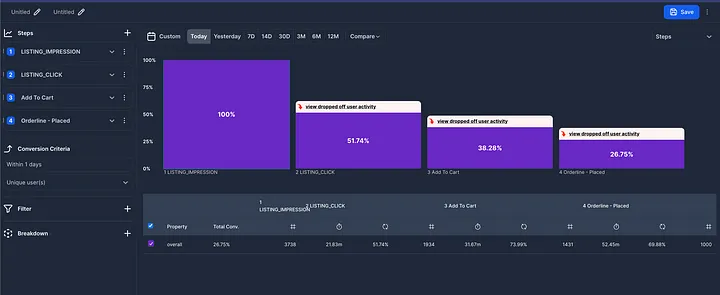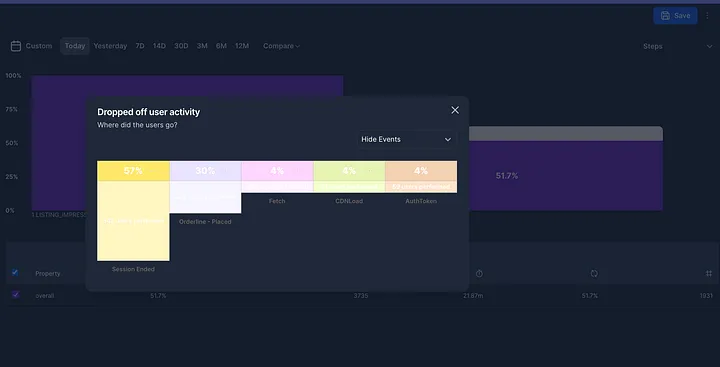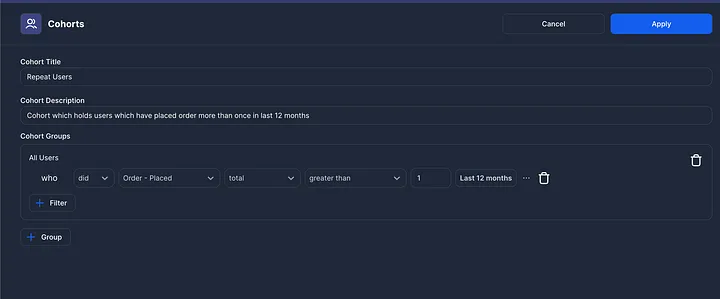Part-1: Crafting the Perfect Funnel for GTM Targets

In every business across the industry, funnel analytics stand out as a critical area of focus for businesses aiming to enhance their strategies. Essentially, a data funnel enables hierarchical examination, allowing for a systematic refinement of data to identify specific trends or insights.
This blog, split into two parts, delves into creating robust funnels to strengthen your business’s online presence:
- Part 1: Developing Funnels for Monitoring Conversions and Identifying User Drop-offs. [This blog]
- Part 2: Implementing Automated Marketing Funnels for Tailored Campaigns and Engagements.
For these analyses, we’ll utilize Percept Insight, notable for its capabilities in generating real-time funnel insights and facilitating automated marketing engagements.
1. Determining the KPIs
The foundation of crafting any insightful funnel begins with identifying the appropriate KPIs (Key Performance Indicators) tailored to your business needs. For e-commerce entities, typical KPIs include:
- Listing Discovery: The number of impressions a product listing receives.
- Listing View: The instance when a user interacts with a listing by clicking on it.
- Add to Cart: The action of a user adding a product to their shopping cart.
- Place Order: The final step of a user completing a purchase.
For businesses that also monitor the post-purchase journey, the KPIs would adjust to capture the nuances of after-sales engagement and customer satisfaction.
2. Constructing the Funnel
2.1. Measure the drop-off at each level
With a platform like Percept Insight, constructing funnels becomes intuitive, enabling you to visualize drop-offs at various stages of the order process. By analyzing these funnels, you can uncover critical insights.

For instance, this basic order funnel reveals that over 50% of users do not engage with the listings presented to them. Such a significant drop-off rate can lead to valuable conclusions, suggesting possibilities like the irrelevance of listings to users or the listings’ value propositions not being compelling enough.
2.2. Tracking the Root Cause of Drop-offs
Once you’ve gained a high-level overview of the drop-off patterns, delving into the underlying causes or symptoms behind these drop-offs is crucial.
To facilitate this analysis, I frequently utilize the "DropOff Activity" view. This feature within the platform simplifies the investigation process by revealing the last event or interaction a user had before exiting the flow, all with just a single click.
This insight is instrumental in diagnosing and addressing the factors contributing to user disengagement.

This view reveals that a significant portion of users’ last interaction was marked as “Session Ended,” indicating that they exited the application after viewing the listing without proceeding to add items to their cart or engaging with any other options. Armed with this knowledge, we can now embark on a more detailed investigation by examining the metrics across various user segments.
Key questions to explore include:
- How did repeat customers fare in this step? What was their drop-off rate?
- How does this trend compare among first-time customers?
- Did the geographical location of users influence their behavior in this context?
- Crucially, were there any specific issues with the listings themselves that could have contributed to the drop-off, such as items being out of stock or unavailable in certain areas?
Addressing these questions allows us to pinpoint more precisely the factors leading to user drop-offs and tailor our strategies to enhance user engagement and conversion rates.
2.3. Segmenting Your Funnel Analysis with Cohorts
Cohorts is an invaluable feature I frequently employ to dissect how distinct segments of users interact with the platform.

The behavior and discovery journey of a new customer, encountering the platform for the first time, inherently differ from those of repeat users. By segmenting these users into different cohorts and analyzing their behaviors through separate funnels, we significantly reduce noise in the data.
This tailored approach allows for the extraction of clearer, more actionable insights, as it accounts for the varying motivations and experiences of each user group.
3. Conclusion
Through the steps outlined, from identifying key performance indicators to dissecting funnel drop-offs and segmenting user cohorts, we’ve laid the groundwork for a comprehensive funnel analysis strategy.
This approach not only enhances our understanding of user behavior and interaction with our platform but also sets the stage for the next crucial phase: leveraging these insights to automate marketing nudges and actions.
In the forthcoming continuation blog, we will delve into how to effectively apply the insights gleaned from our funnel analysis to automate personalized marketing campaigns and actions.
This will not only streamline our marketing efforts but also ensure that we are engaging our users in the most relevant and impactful way.
Stay tuned as we explore the transformative potential of automated marketing nudges in amplifying our marketing strategies and driving meaningful engagement.
